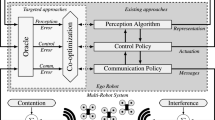Abstract
In the grasping process of the robot, the pose of robot should adapt to the change of the object's pose. In order to avoid the cumbersome calibration and difficulty of inversion in the existing vision-based robotic arm-grasping methods, a robotic arm grasping and tracking method based on Gaussian mixture of machine vision model (MGV) are proposed. This method uses Gaussian mixture model of machine vision to build the mapping relationship between the observed variables of the object and the robot joint variables. In the learning phase, the Gaussian mixture model of machine vision is used to directly construct the mapping from the pose of the target object to the joint angle of the manipulator. In the grasping stage, the pose of the target object is acquired through the camera, and the generation probability of the pose under each Gaussian component is calculated, respectively, and the Gaussian process regression corresponding to the Gaussian component with the largest posterior probability is selected to calculate the corresponding manipulator joint angle. The experimental results show that using Gaussian mixture machine vision model can make the robot manipulator grasp and track better than using single Gaussian process model.











Similar content being viewed by others
References
Mei G, Xu N, Qin J et al (2019) A survey of Internet of Things (IoT) for geohazard prevention: applications, technologies, and challenges. IEEE Internet Things J 7(5):4371–4386
Usak M, Kubiatko M, Shabbir MS et al (2020) Health care service delivery based on the Internet of things: systematic and comprehensive study. Int J Commun Syst 33(2):e4179
Fu H, Wang M, Li P et al (2019) Tracing knowledge development trajectories of the internet of things domain: a main path analysis. IEEE Trans Ind Inf 15(12):6531–6540
Zhang X, Liu S, Chen X et al (2018) Health information privacy concerns, antecedents, and information disclosure intention in online health communities. Inf Manag 55(4):482–493
Li R, Qiao H (2019) A survey of methods and strategies for high-precision robotic grasping and assembly tasks—some new trends. IEEE/ASME Trans Mechatron 24(6):2718–2732
Ginestra JC, Giannini HM, Schweickert WD et al (2019) Clinician perception of a machine learning–based early warning system designed to predict severe sepsis and septic shock. Crit Care Med 47(11):1477–1484
Parshuram CS, Dryden-Palmer K, Farrell C et al (2018) Effect of a pediatric early warning system on all-cause mortality in hospitalized pediatric patients: the EPOCH randomized clinical trial. JAMA 319(10):1002–1012
Azimi I, Rahmani AM, Liljeberg P et al (2017) Internet of things for remote elderly monitoring: a study from user-centered perspective. J Ambient Intell Humaniz Comput 8(2):273–289
Liu Y, Zhang L, Yang Y et al (2019) A novel cloud-based framework for the elderly healthcare services using digital twin. IEEE Access 7:49088–49101
Zeadally S, Bello O (2021) Harnessing the power of Internet of Things based connectivity to improve healthcare. Internet of Things 14:100074
Kang S, Baek H, Jung E et al (2019) Survey on the demand for adoption of Internet of Things (IoT)-based services in hospitals: investigation of nurses’ perception in a tertiary university hospital. Appl Nurs Res 47:18–23
He D, Chan S, Guizani M (2018) Security in the Internet of Things supported by mobile edge computing. IEEE Commun Mag 56(8):56–61
Dhanvijay MM, Patil SC (2019) Internet of Things: a survey of enabling technologies in healthcare and its applications. Comput Netw 153:113–131
Lin SX, Liu HZ, Chen SJ et al (2017) Optimization and implementation of Zigbee wireless location algorithm. Revest de la Faulted de Ingenerate 32(5):396–404
Dang LM, Piran M, Han D et al (2019) A survey on Internet of Things and cloud computing for healthcare. Electronics 8(7):768
Panchatcharam P, Vivekanandan S (2019) Internet of Things (IOT) in healthcare–smart health and surveillance, architectures, security analysis and data transfer: a review. Int J Softw Innov 7(2):21–40
de la Torre DI, Alonso SG, Hamrioui S et al (2019) IoT-based services and applications for mental health in the literature. J Med Syst 43(1):11
El Kafhali S, Salah K (2018) Performance modelling and analysis of Internet of Things enabled healthcare monitoring systems. IET Netw 8(1):48–58
Wang B, Kong W, Guan H et al (2019) Air quality forecasting based on gated recurrent long short term memory model in Internet of Things. IEEE Access 7:69524–69534
Baig MM, Afifi S, GholamHosseini H et al (2019) A systematic review of wearable sensors and IoT-based monitoring applications for older adults: a focus on ageing population and independent living. J Med Syst 43(8):233
Shen T, Radmard S, Chan A et al (2018) Optimized vision-based robot motion planning from multiple demonstrations. Auton Robot 42(6):1117–1132
Acknowledgements
The study was supported by “School-enterprise Cooperation Project” for Domestic Visiting Engineers of Institutions of Higher Learning in 2020, China (Grant No. fw20200879).
Author information
Authors and Affiliations
Corresponding author
Ethics declarations
Conflict of interest
The authors declared that they have no conflicts of interest to this work. We declare that we do not have any commercial or associative interest that represents a conflict of interest in connection with the work submitted.
Additional information
Publisher's Note
Springer Nature remains neutral with regard to jurisdictional claims in published maps and institutional affiliations.
Rights and permissions
About this article
Cite this article
Lou, J. Crawling robot manipulator tracking based on gaussian mixture model of machine vision. Neural Comput & Applic 34, 6683–6693 (2022). https://doi.org/10.1007/s00521-021-06063-x
Received:
Accepted:
Published:
Issue Date:
DOI: https://doi.org/10.1007/s00521-021-06063-x



